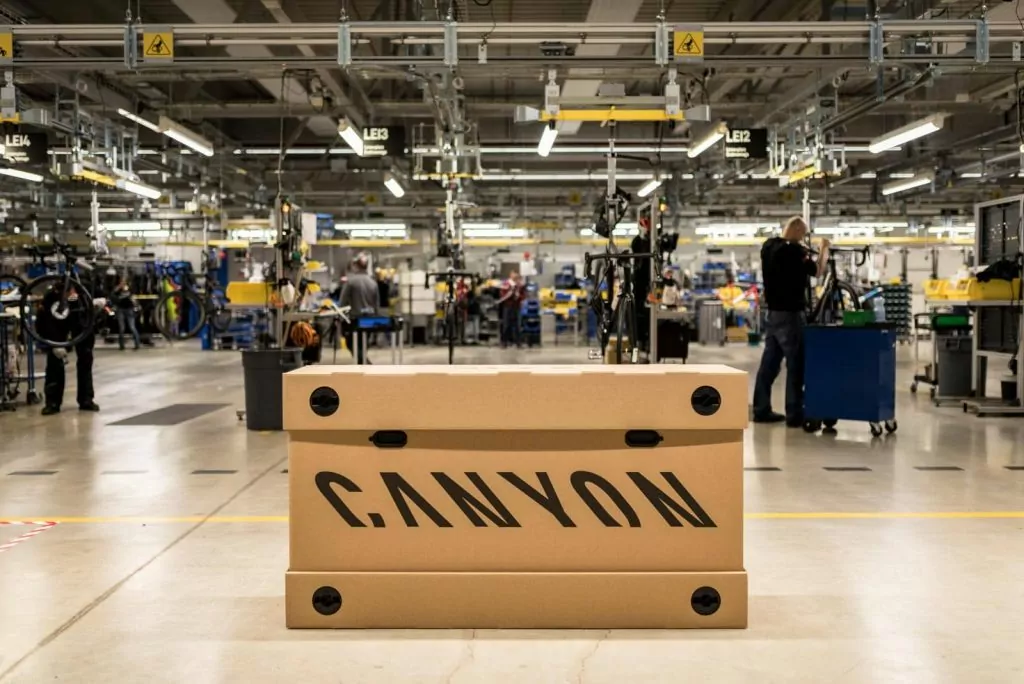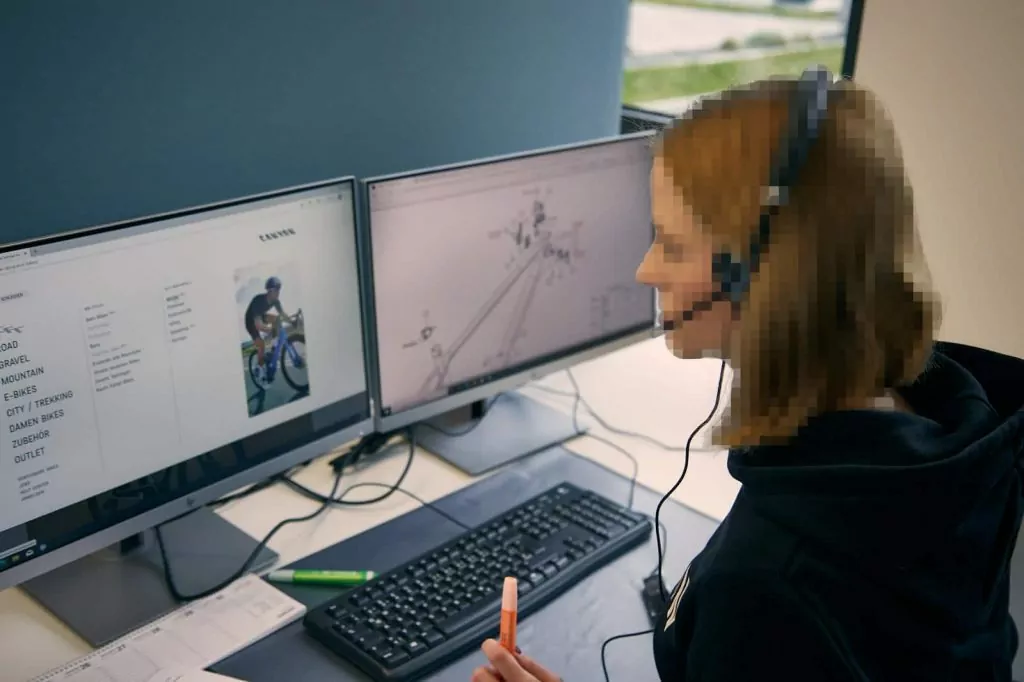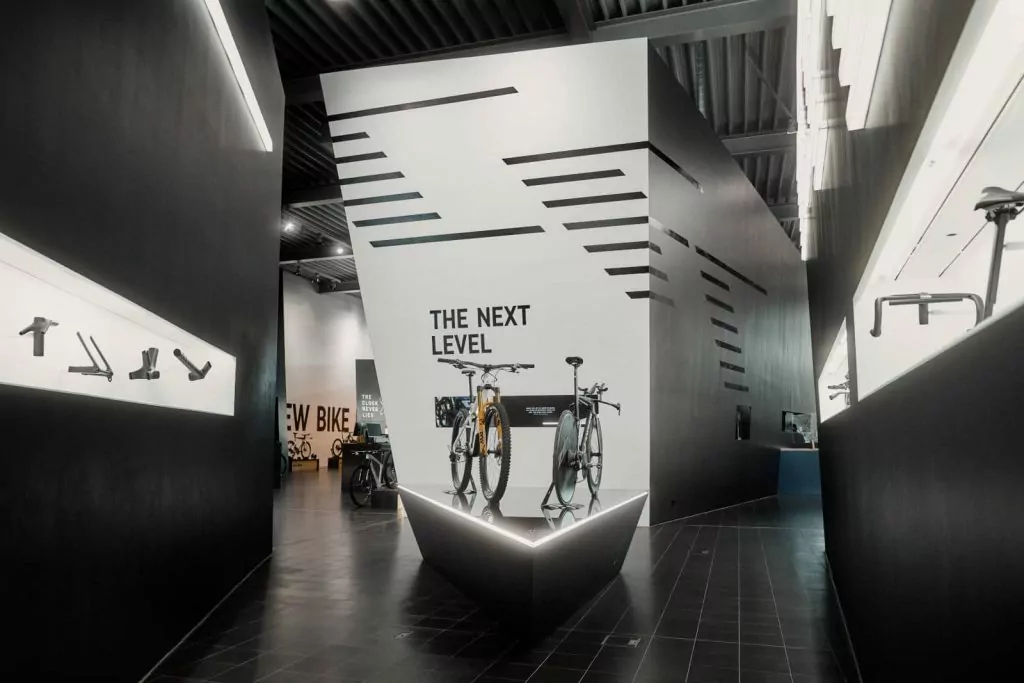TUP implemented two large-scale projects for the bicycle manufacturer Canyon. In a short time, a new production site with optimized intralogistics was created, laying the foundation for state-of-the-art manufacturing and the associated growth potential. As a follow-up project, a cross-site symbiosis of production and warehouse logistics was realized by TUP thanks to individual software solutions, consulting and planning. The result is a scalable overall concept individually tailored to the business processes of the company, which allows the online vendor to ideally exploit the opportunities of the rapidly growing market by consolidating and increasing production capacities using digitally controlled line manufacturing.
The fact that online retail has developed into a strong industry has become clear to everyone, especially since the continuing boom during the Corona crisis. According to current figures from the German E-Commerce and Mail Order Association (Bundesverband E-Commerce und Versandhandel e.V.), e-commerce in Germany contributes around 100 billion euros/year to the gross domestic product and thus establishes itself only just behind the automotive industry.
For Canyon, a globally popular manufacturer of mountain bikes and road bikes, this is not surprising. The company has relied on online retailing since its founding and is well aware of the advantages: direct interactions increase customer commitment and satisfaction, whereas bypassing third-party suppliers allows for attractive prices.
Another important pillar for sustainable success in e-commerce is a scalable, transparent and customized solution that supports manufacturing and logistics processes. This is the only way to respond to the increasingly frequent and severe order peaks, which have only been exacerbated by the pandemic. A development that will lead to waiting times of up to 500 days for bike components in 2022.
The Brief Overview
TUP implemented two major projects for bicycle manufacturer Canyon. First, a new production site with optimized intralogistics was built in a short period of time, creating the basis for modern manufacturing and further growth potential. As a follow-up project, a cross-site symbiosis of production and warehouse logistics was realized by TUP. The result is a scalable overall concept individually tailored to Canyon’s business processes.
It enables the online vendor to take advantage of the opportunities offered by the rapidly growing market by consolidating and increasing production capacities using digitally controlled line production.
The initial situation of the projects
Faced with steadily growing demand, a solution had to be found to optimize Canyon’s current logistics situation, as existing capacity was fully utilized and spread across different warehouse locations. In order to cope with the increasing number of orders, the company planned to build a new site. Production and intralogistics were to be merged in order to make assembly processes more effective and inventory management and the associated logistics more transparent.
However, this unique challenge could not be met by a standard approach. Therefore, TUP was commissioned to develop a solution specifically adapted to the needs and requirements, to accompany the implementation as general planner for logistics and to optimally support the processes with software. The intralogistics experts from Stutensee near Karlsruhe therefore accompanied the project from conception to implementation and thus created more efficient process flows within a short planning and implementation period.
In a second follow-up project with a tight schedule of only three months, TUP was commissioned with the development of a further site. Thus, the software already developed in the first project was operationally extended to another warehouse. TUP tested and implemented this within the shortest possible time, as the software modules could be made instancable without version conflicts or incompatibilities. This was possible because TUP constantly accompanied the further development of the processes at Canyon and introduced a new multi-site solution also related to the future internationalization. As a result, cross-system networking of additional warehouses will be possible without any problems in the future.
What was the initial course of the project and what solutions were in operation for the warehouse with smart assembly?
At the new Canyon production and goods warehouse near Koblenz, production chains and intralogistics were to be made more efficient in order to cope with the increasing demand in e-commerce.
“TUP was the right partner to optimize and automate our logistics processes. In addition, it was important for us to have a partner who would provide us with holistic support in logistics planning, the warehouse management system and warehouse technology as a general planner – all from a single source” – Canyon project manager André Koch
The requirements for TUP were, on the one hand, the digitalization of documentation from goods receipt to goods issue, as well as easier access to all data via mobile devices. In addition, digital, two-stage picking was to be introduced and assembly was to be implemented as dynamically controlled line production.
This results in transparent inventories and processes for all employees, as the flow of assembly and goods can also be displayed and controlled in real-time. This now enables Canyon to react quickly and flexibly to the daily order situation.
What were the special features and requirements during the first project?

Since TUP provided comprehensive support for the new Canyon Factory building, the company was always able to react quickly to adaptations and implement them individually together with Canyon. Connecting a warehouse management system (WMS) to the assembly line within a short period of time and completing the entire process from the requirement document to the implementation was a major challenge. TUP was able to complete the project on time and within budget. Canyon’s set goals and expectations were thus met in full.
Furthermore, TUP developed a special modular software for Canyon, called TUP.SML (Smart Mobile Logistics), which allows the use of Android-based end devices but also commercially available smartphones for mobile data collection in the warehouse as well as a connection of headsets and ring scanners. These solutions provide Canyon with free terminal selection, easy addition of additional dialogs to the system, and enable an uninterrupted production chain. In the event of an unforeseen failure of one device, the work can be continued in the same place with another terminal device thanks to the TUP software.
When the devices equipped with the software are in operation, all data as well as work steps are recorded throughout the entire process chain and transferred to the TUP.WMS warehouse management system developed by TUP. Here, transfer to downstream systems such as the enterprise resource planning system (ERP) or manufacturing execution system (MES) is also possible.
Thanks to its adaptability, TUP.WMS enables “just-in-sequence” assembly line management that is dynamic and geared to the order situation. For this purpose, so-called master and slave tours have been developed to control and efficiently supply the production chains. For example, master tours pool information on bicycle frames. Depending on the position in the production chain, the slave tours then supply suitable add-on parts for the respective frame. Individual items can also be broken down into components suitable for assembly if they have to be installed at different points in the line production.
TUP.WMS takes over the management of the loading aids, the so-called carts, which are required as materials handling equipment for picking, the assembly buffer and the delivery. The system ensures that there is always sufficient transport capacity available.
Furthermore, the TUP modules support the control of materials handling technology between four picking levels (TUP.MFC – material flow controller). A connection layer between TUP solutions, MES and the ERP system enables the efficient integration of further TUP modules or third-party software to control the material flow via a standardized message protocol.
This first individual compilation of TUP solutions, was combined as a functional package “Canyon Logistic System” (CLS), in order to be able to provide the option of an assembly line for further locations if required, which was to be done in the second project step.
What were the special features and requirements during the second project?

The next step was for the CLS software to support an additional warehouse. For this purpose, another module was developed that makes the CLS software available for this and future additional locations (CLS.GLOBAL). This ensures transparency and further simple, individual adaptation to the requirements of the respective sites.
Since the TUP solutions are each compatible, only one new software layer had to be added. Due to TUP’s development approach, this was possible without restricting the functionality of the previously existing software. As a result, Canyon can now access the CLS.GLOBAL global control layer. “There is only one interface, no matter how many decentralized sites are integrated, each with their own individual topology,” Gilbert adds. Through custom development, the bicycle manufacturer now has the tools it needs to expand the resilience and scalability of its business model over the long term.
The software provides communication capabilities between higher-level systems, such as CEP service provider systems, and lower-level systems, such as each warehouse’s individual CLS. The software supports every common technology for data and information exchange. The networking enables central monitoring of the TUP.WMS of all warehouses and thus creates a multi-warehouse capability. This means that additional warehouses can be connected at any time, which then benefit just as much from the continuously evolving functions.
The outlook

With the software package, Canyon can continue to expand assembly capacities to other warehouses as needed. The fast and effective adaptations enable the company to continue to meet the unbroken growth as well as the requirements of e-commerce and thus to continue to ship bicycles all over the world in the usual quality.
Thus, TUP as an IT service provider can best support Canyon in the face of the future challenges of the fast-moving e-commerce market.
This report originally appeared in the 05/2022 issue of the trade journal (German) materialfluss and is available here as a PDF download in an abridged version.
Also available in Deutsch (German)